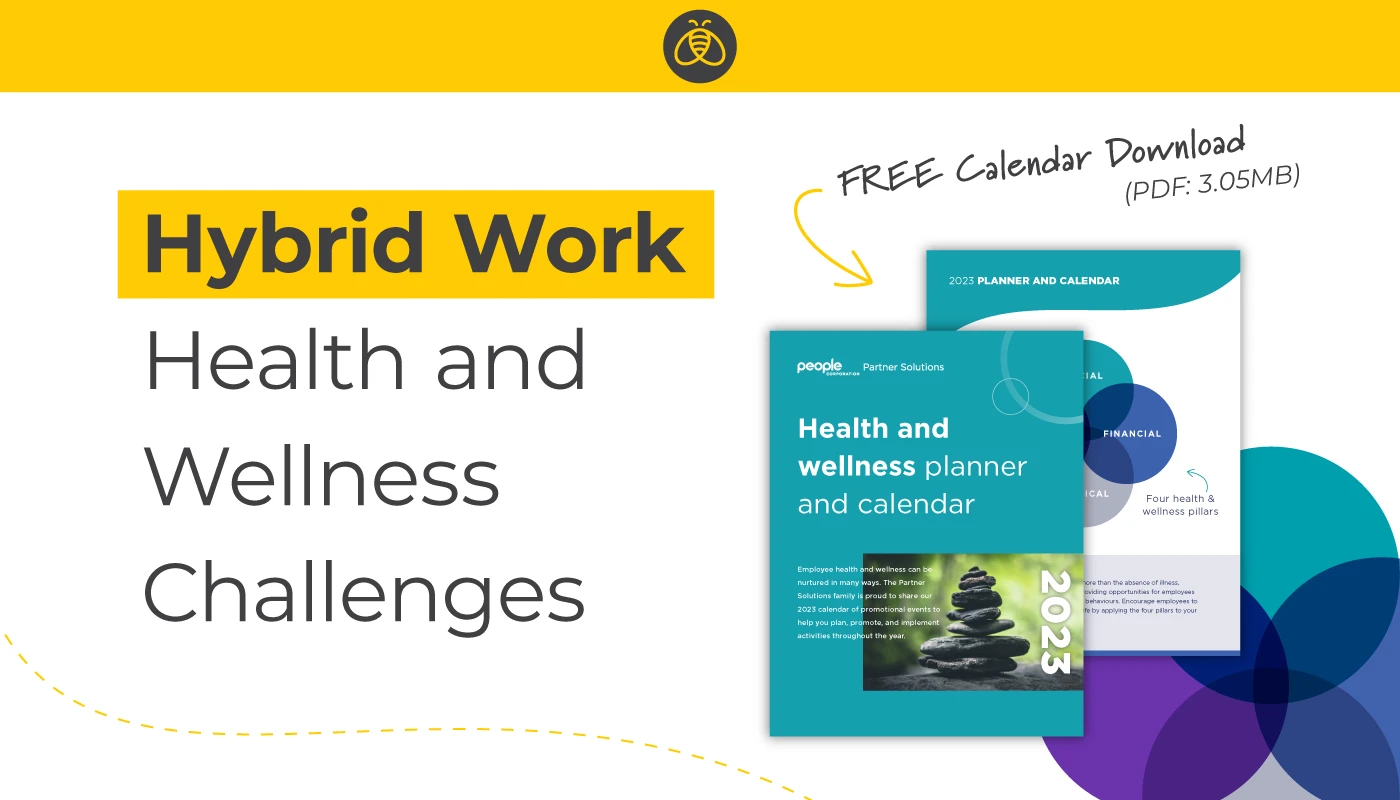Hybrid Work Health and Wellness Challenges [FREE calendar download (PDF: 2MB)]
By: Benefits by Design | Tuesday January 17, 2023
Updated : Monday July 7, 2025
The 2023 Health and Wellness Calendar is no longer available for download on the website. For historical versions, please reach out via the Contact Us submission form.
The challenges faced by hybrid workers include those faced by both in-person and remote workers. Essentially, they may have twice as many. Don’t feel too bad though, since the flexibility of hybrid work affords employees perks of both worlds.
Employee Collaboration (within teams and between different teams)
The advent of the pandemic rapidly forced us all to get used to virtual teams. “You’re on mute” was the phrase of 2020 and 2021!
And while many virtual collaboration tools emerged to help, there is still something to be said about brainstorming and organizing projects while in the same room.
In-team cooperation and mutual support can be easier since team members tend to interact more frequently. There is also a fine line between having too many virtual meetings – zoom fatigue anyone? – and not seeing each other enough. However, when employees aren’t in the office, the silo effect between teams can be more pronounced.
Company Culture Loss
How do you keep up participation in non-mandatory social events, motivational contests, and general engagement with work?
When employees are together often and frequently, they tend to have closer relationships. They will have inside jokes from funny moments, and they’ll understand each other’s passions and dislikes more thoroughly. They’ll also recognize each other’s strengths and weaknesses and can help each other gain confidence and experience in areas a team member may struggle with at work.
While employee productivity and engagement has not been affected by the remote environment, people do feel disconnected. “Sixty-three per cent of plan members who can work from home reported feeling less connected to their co-workers and their organization” – 2022 Benefits Canada Healthcare Survey
6 Dos and Don’ts for Building a Successful Workplace Culture
Employee Burnout or Lack of Engagement
When employees are going between working remote and at the office, work-life-balance can tend to get blurred. Another concern is tools and resources. If not everything is available online, employees may not be able to complete all tasks they set out to accomplish. This could lead to wasted time, causing stress and extra work. Eventually employees could burn themselves out.
The opposite could also be true. Some employees may work fewer hours when at home, or just barely complete the minimum tasks required. A lack of motivation could be the culprit, especially if the employee performs well when in the office.
8 Ways to Help Employees Reduce Stress and Boost Productivity
Supporting the Health and Wellness of Hybrid Workers
It’s not all doom and gloom. There are ways to mitigate the above concerns to make hybrid work function smoothly and provide employees with the health and wellness benefits they deserve. One of those perks is the flexibility of hybrid work, as long as it’s done with care.
Defined Hybrid Work Policies
Perhaps the most crucial step to providing flexible working options is to get it in writing. Create a hybrid work policy that defines all aspects and questions that may surface. A good policy should consider the following:
- Eligibility – which roles in the company will be allowed the option of hybrid work?
- In-office time – will employees be required to spend a certain number of days per week or month in the office? Or will it be a percentage of their time?
- Who decides – will it be up to the employee to choose their schedules? Or will their manager be responsible? Or will it be a company-wide decision that all employees must abide by?
- Designated Workspaces and Equipment – will the employer provide desks and chairs, or a stipend to purchase these types of things? Do employees need to transport a laptop back and forth, or will they have a dedicated workspace both at home and in the office? What types of requirements will there be surrounding ergonomics and at-home distractions?
- Standard Working Hours – how many hours are employees expected to work: at home and at the office. When should they NOT be working? (Weekends, after a specific time each day)
- Reporting – How do employees check-in or confirm they are “working” while at home? Who do they report to in case of an emergency or injury while working from home?
- Confidentiality and security – no matter where employees are working, employers should have a policy to ensure employees are keeping information confidential and that they are using best practices when it comes to online and offline security.
Defining the above gives employees concrete answers. And since knowing is half the battle, it can help put them at ease.
Employee Scheduling
This is probably one of the biggest challenges. But if done correctly, it can be a huge benefit. Depending on the structure of a company, a fantastic way to support healthy employee relationships is to align the days that employees are in the office. If this is not possible – perhaps due to a requirement of customer service coverage – consider breaking teams into smaller groups that rotate together.
Work-life Balance
The flexibility of hybrid work is all about positive work-life balance. As long as employees are ensuring they are giving themselves the time and space away from the computer screen or their work phone. Lead by example: Highlight executives, managers and coworkers enjoying their own after-hours activities.
This is where your defined working hours from your hybrid work policy can help. It shows employees that they are not expected to work untold hours late into the evening.
“One of the main appeals of a hybrid model is the balance between autonomy and collaboration. Promoting a culture of trust is essential to managing hybrid employees.” – Career Edge
Company Culture
Corporate culture is extremely important when it comes to employee job satisfaction. It can also be a measurement of employee sentiment. Employee wellness can be cultivated through engaging activities, both virtually and in-person. Try lunch and learns, or holiday themed games during work hours that let employees connect and chat about non-work-related topics.
7 Employee Wellness Activities to Keep Your Company Culture Thriving
Employee health and wellness is continually evolving as we learn what does and doesn’t work, and integrate technology more and more. And the adaptation to hybrid work presents its own unique challenges. With the right strategy, however, these difficulties can be overcome.


